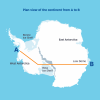Mendel
Senior Member.
If you have two opposite horizons, and adjust the stick so you can sight along it to see one horizon, and then sight in reverse and see the sky, that proves horizon drop, yes. Walter Bislin's site lets you calculate the drop angle you should be seeing at the height you'll be at, with correction for atmosphere; or Mick's own calculator here on metabunk.in such a minimalistic fashion that literally anyone who can get their hands on a stick (and a peninsula, but the spirit level's not needed) can reproduce it.
A theodolite app on a smartphone might also work for this experiment.
How would you go about doing it with no equipment?

